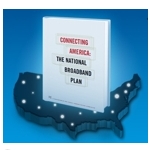Part two of our three part National Broadband Plan series explains how the Connect America Fund would replace today’s voice-based universal service fund and how inter-carrier compensation also would get a revamp
 A critical element of the National Broadband Plan issued in mid-March is a plan to transition today’s voice-focused high-cost Universal Service Fund into a broadband-focused fund called Connect America Fund. The goal of the new fund is to make broadband speeds of at least 4 Mb/s downstream available to virtually all U.S. homes within the next 10 years. The crafters of the plan also recommend the creation of a mobility fund with the aim of ensuring that no states are lagging significantly behind the national average for 3G wireless coverage.
A critical element of the National Broadband Plan issued in mid-March is a plan to transition today’s voice-focused high-cost Universal Service Fund into a broadband-focused fund called Connect America Fund. The goal of the new fund is to make broadband speeds of at least 4 Mb/s downstream available to virtually all U.S. homes within the next 10 years. The crafters of the plan also recommend the creation of a mobility fund with the aim of ensuring that no states are lagging significantly behind the national average for 3G wireless coverage.
“The National Broadband Plan is about building the networks of the 21st century and making sure every American is connected,” said Blair Levin at a press conference on March 5 to announce the proposed Universal Service reforms. At that time, Levin was executive director of the Omnibus Broadband Initiative and in that role he headed up the team that crafted the National Broadband Plan. Levin has since left the FCC to join the Aspen Institute.
Today’s Universal Service program is funded by communications service providers based on a percentage of revenue. Payments from the high-cost fund go to pay part of network costs for small telcos serving areas where services traditionally were expensive to deliver.
The broadband plan proposes to achieve its broadband deployment goals without significantly increasing the size of the Universal Service Fund. Instead the goal is to re-purpose funds that today may be used to support voice-only networks and encouraging service providers to shift voice traffic onto broadband delivery platforms. The plan notes, however, that Universal Service goals could be achieved more quickly if Congress were to raise an additional “few billion dollars per year over two to three years.”
The plan also opens the door to the possibility that the FCC could calculate carrier contributions to the Universal Service Fund based on a broader revenue base. Although current contributions are based on a percentage of telecommunications revenues, the plan recommends that the FCC also consider including broadband revenues in the base.
Key reforms
The Connect America Fund is intended to target what are sometimes called “market failure” areas where market conditions do not support commercial broadband build-outs. That’s a reform that will be welcomed by opponents of the current system who have questioned the lack of a mechanism to periodically evaluate whether market conditions have changed in areas that traditionally were expensive to serve.
Under the proposed reforms only a single landline and a single wireless provider in a territory would be eligible for funding under Connect America—another move that should be welcomed by policy makers and by many corners of the telecom industry. In recent years carrier contributions to the Universal Service fund have increased, in large part because multiple carriers have been able to receive USF support for serving the same territory—and at the same level of support. Small incumbent telcos have opposed this practice, arguing that the competitive carriers (sometimes referred to as CETCs), which typically are cellular operators, may only offer service in areas within a territory that are the least expensive to serve.
Which carriers would receive funding for an area under the new plan remains to be determined. The plan says decisions should be made on a “provider and technology-neutral basis,” and in the mid-March press conference, Senior OBI Policy Advisor Carol Mattey talked about the possibility of a “market-based mechanism to select the provider and the amount of support.”
The National Broadband Plan includes many pages of statistics and charts about the state of broadband deployment in the U.S., noting that seven million U.S. homes do not have access to broadband today. The plan crafters also noted that of those seven million homes, only about one-third are in areas served by the small rate-of-return carriers, whose operating margins are essentially ensured based on regulated factors. The other two-thirds are served by larger price cap carriers, including the former Bell companies, which do not have rate-of-return assurances but instead may be able to earn higher or lower margins, depending on market conditions.
In attempting to reconcile this reality with the fact that rate-of-return carriers are the primary beneficiaries of today’s Universal Service program, the plan proposes some changes that have not been well received by small carrier organizations, including shifting a higher percentage of funds to price cap carriers. The plan also recommends freezing support to small rate of return carriers and phasing out rate of return regulations.
“Rate-of-return regulation was implemented in the 1960s, when there was a single provider of voice services in a given geographic area that had a legal obligation to serve all customers in the area and when the network only provided voice service,” the National Broadband Plan says. “Rate-of-return regulation was not designed to promote efficiency or innovation. . . In an increasingly competitive marketplace with unsubsidized competitors operating in a portion of incumbents’ territories, permitting carriers to be made whole through USF support lessens their incentives to become more efficient and offer innovative new services to retain and attract customers.”
Rate-of-return telcos argue that they are still the only telecom service providers in some areas and that if they are forced to become price cap carriers, some territories might become uneconomical to serve. But those telcos may find they have little clout in opposing the proposed changes. In the past, their interests closely aligned with mid-tier carriers such as CenturyLink and Frontier, who were willing to throw their weight behind policy measures. But in recent months some mid-tier carriers have transitioned almost 100% into a price cap approach.
Inter-carrier compensation
The crafters of the National Broadband Plan recognized that Universal Service reforms would need to go hand in hand with reforms to the inter-carrier compensation (ICC) system–the system that compensates carriers on a per-minute basis for terminating calls to their customers from other carriers. Many small rural telcos rely heavily on inter-carrier compensation to cover some of their network costs, but critics say the per-minute charges are higher than the actual cost of terminating traffic and that in an era of flat-rate monthly pricing the system is outmoded.
The National Broadband Plan recommends phasing out per-minute access charges by 2020. The first step, targeted for implementation over a period of two to four years, beginning between 2010 and 2011, would move carriers’ intrastate terminating switched access rates to interstate terminating switched access rate levels.
To offset the impact of decreasing ICC revenues, the plan crafters also said they would like to permit gradual increases in the subscriber line charges—a Universal Service funding mechanism that consumers pay as a monthly line item on their phone bills. In addition, the plan recommends that the FCC encourage states to rebalance (in other words “raise”) local rates to offset the impact of lost access revenues.
Even with these changes, the plan notes that some carriers may need support from the reformed Universal Service Fund to ensure adequate cost recovery. The plan suggests that the level of support could be calculated based on an established local rate benchmark.
Because it will take a decade to totally phase out per-minute ICC charges, the plan also recommends taking steps in the near-term to address what are sometimes called “phantom traffic” issues, which have become a growing concern for small telcos. In an effort to avoid paying termination charges, some communications service providers—including cellular operators, VoIP providers and others–have used a variety of methods to avoid paying these charges, a topic Telecompetitor recently covered in detail.
The National Broadband Plan specifically suggests that the FCC prohibit one of these methods–in which the originating carrier fails to provide information necessary for a terminating carrier to bill ICC minutes. In addition, the plan recommends that the FCC should address the treatment of VoIP traffic for purposes of ICC. To date, some VoIP providers have argued that they are not required to pay ICC fees because VoIP is not a telecommunications service.
The plan does not specifically address some other methods by which carriers have avoided paying ICC such as routing long-distance traffic over local trunks.
Authority questions
The National Broadband Plan calls for rolling out Universal Service reforms in three phases. In the first phase, from 2010 to 2011, the plan crafters want the FCC to conduct rulemakings and establish specific parameters. In the second phase, between 2012 and 2016, the plan calls for freezing legacy Universal Service support and beginning the transition to the Connect America Fund. By the end of the third phase, between 2017 and 2020, all funding for voice-only networks would cease.
But before the FCC can implement proposed Universal Service reforms, it must address questions that have arisen about whether it has the authority to regulate broadband. For a number of years, the FCC has treated broadband as a Title I or information service, rather than a Title II or telecommunications service—and while the FCC’s authority over Title II services is well established, the same is not true for Title I services.
With little opposition to the proposed Universal Service reforms, the FCC might have attempted to skirt the authority issue. But that’s not an option in the wake of the recent Comcast decision, in which the Supreme Court ruled that the FCC failed to establish its authority over broadband when it attempted to prevent Comcast from limiting the amount of bandwidth available to certain types of broadband traffic.
Some stakeholders now fear the FCC will attempt to reclassify broadband as a Title II service—a move that could entail some unfortunate consequences, such as requiring broadband providers to file price tariffs. Alternatively, Congress could pass legislation to give the FCC authority over broadband—but most people agree that’s a process that could take years.
A third possibility—and one that would probably be most palatable to the most people—is for the FCC to establish “ancillary” authority over broadband. As Tom Tauke, Verizon’s executive vice president for public affairs, policy and communications explained on a recent Stifel Nicolaus conference call, ancillary authority is when an entity ties an action that it plans to take to a statutory provision that gives the entity the authority to take that action. The FCC used its statutory authority over E911, for example, to establish its ancillary authority to require VoIP providers to support E911 service.
Using the same logic, Tauke argued that the FCC should be able to establish its authority to create a broadband Universal Service fund by extending its statutory authority over Universal Service.
Part One of this series looked at the National Broadband Plan’s ambitious goals and implementation challenges. Part Three will look at plans to free up 500 MHz of spectrum within that same time period to support mobile broadband. Make sure you don’t miss the rest of this series – subscribe to our newsletter, follow us on twitter, or sign up for our RSS feed.

